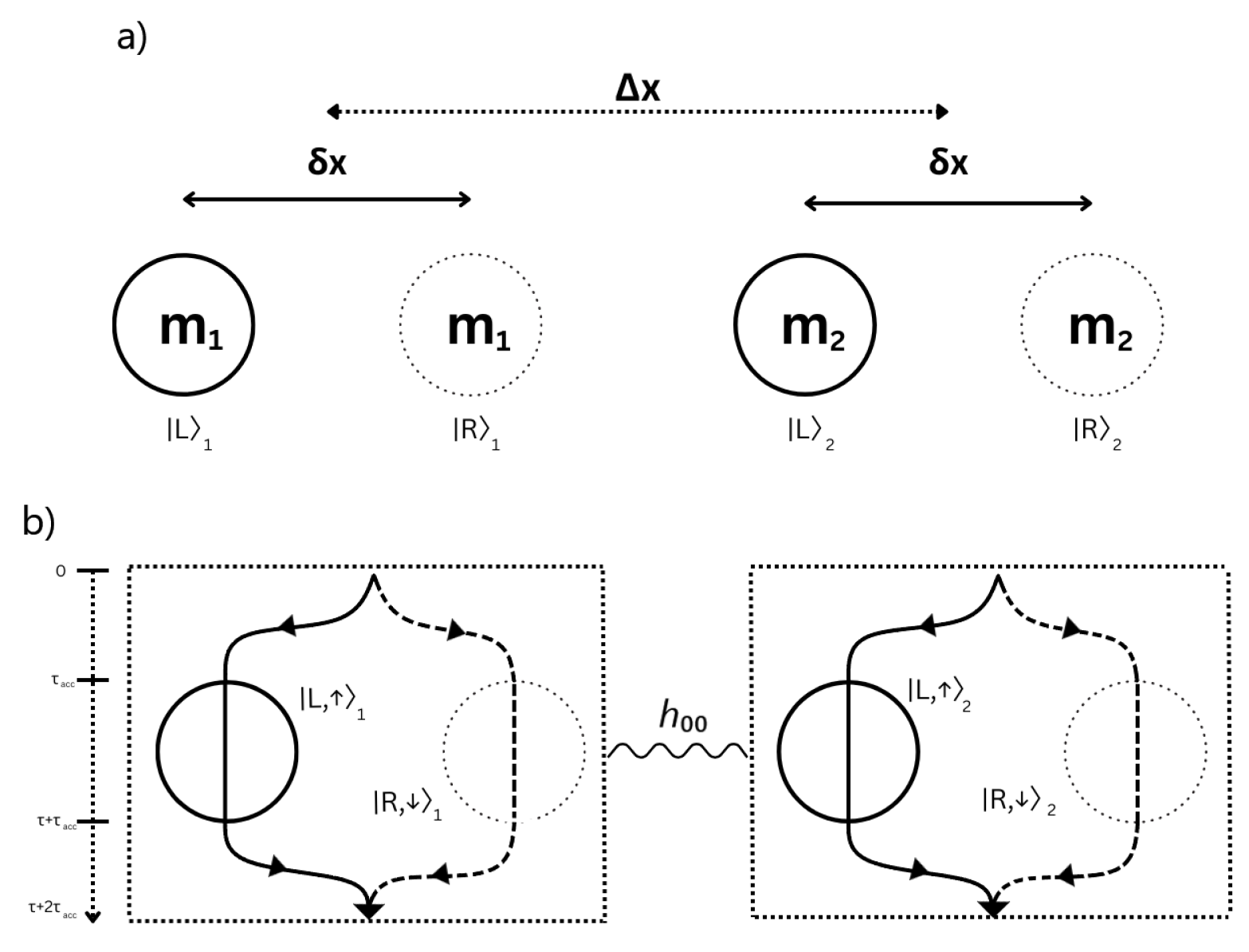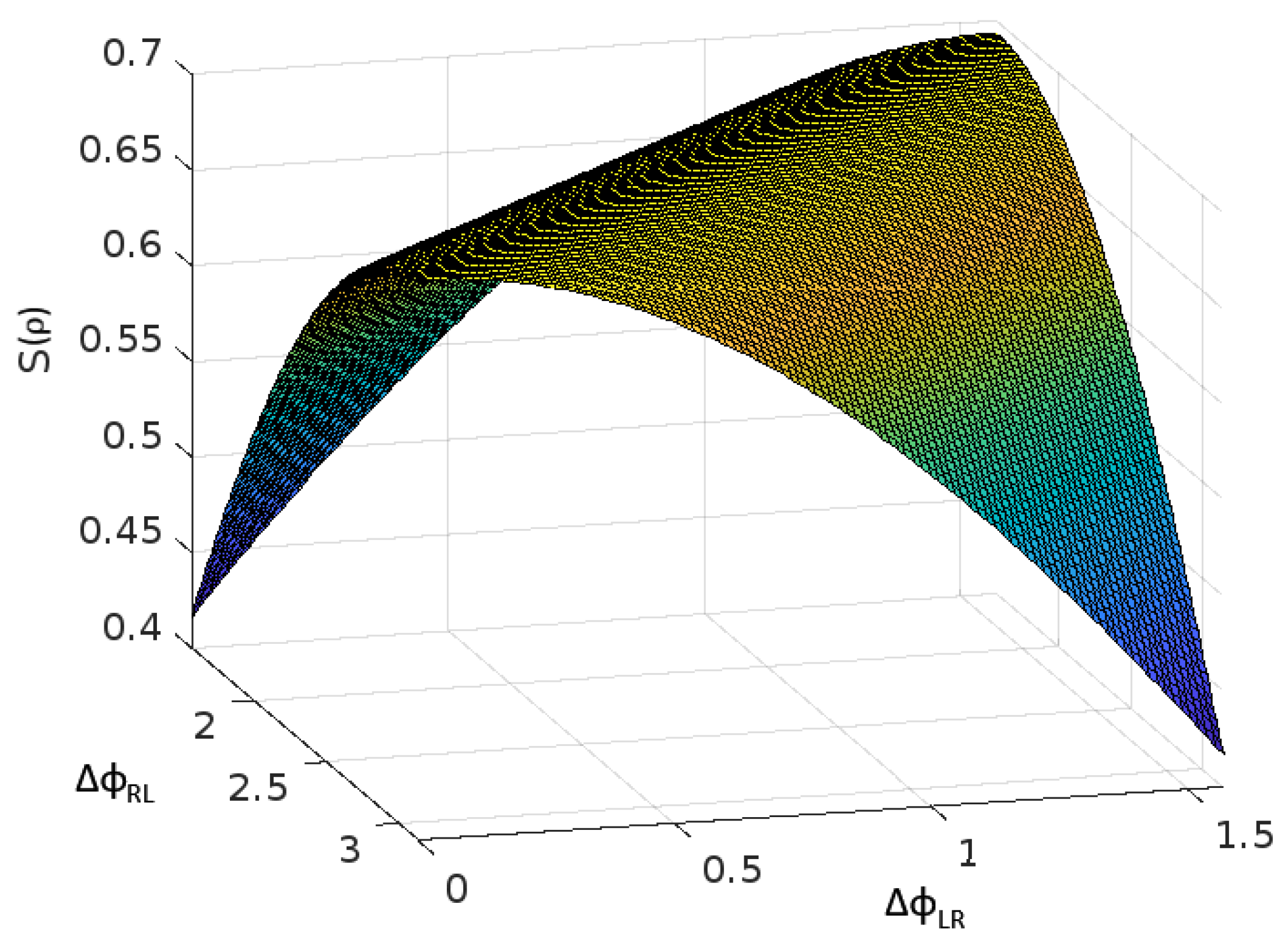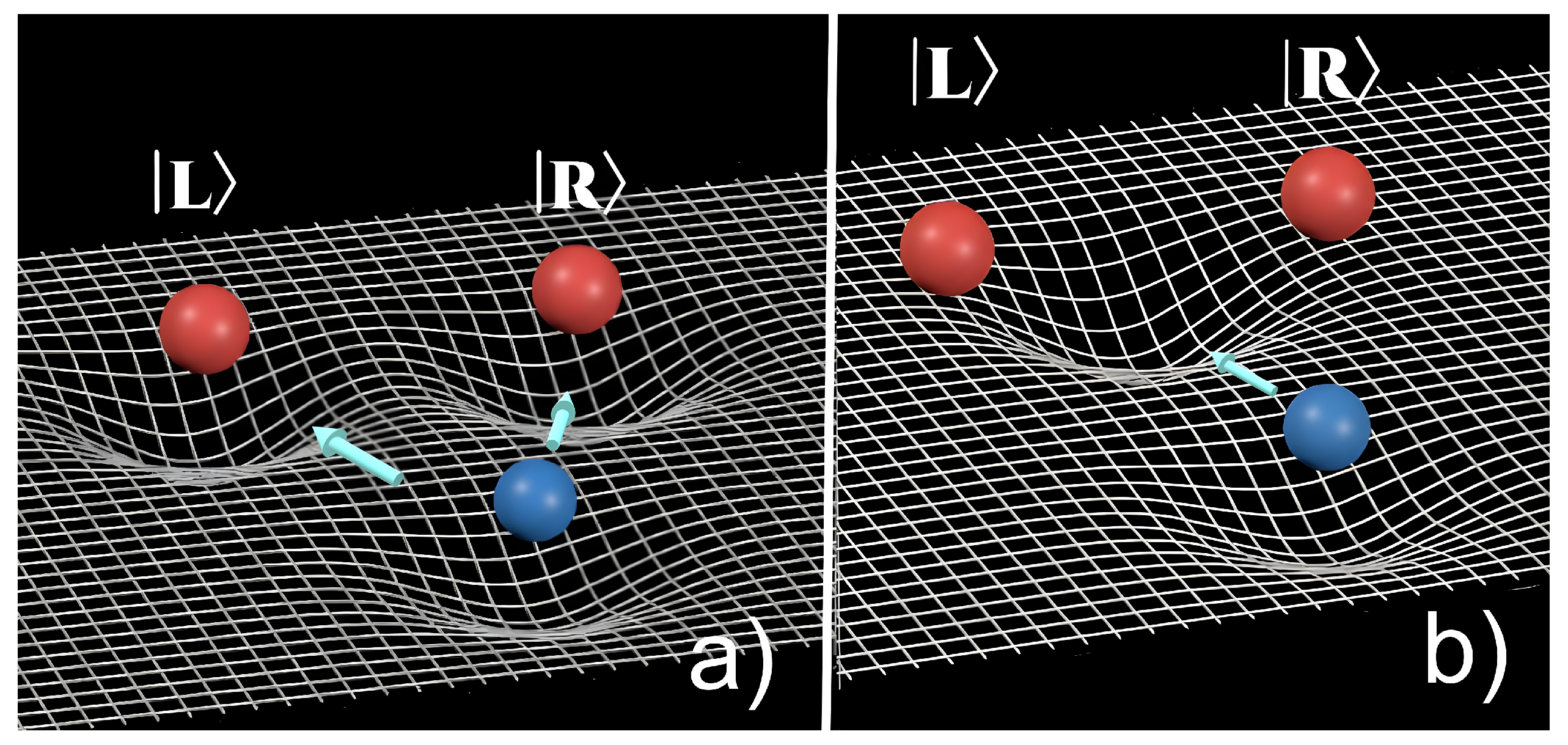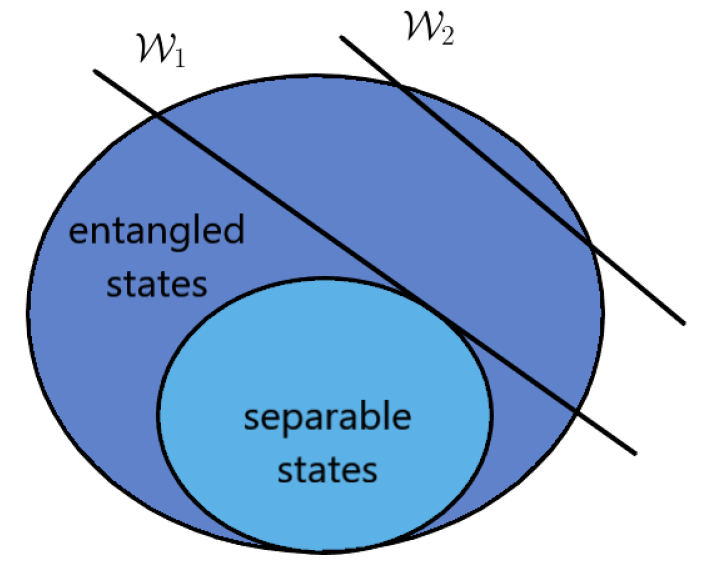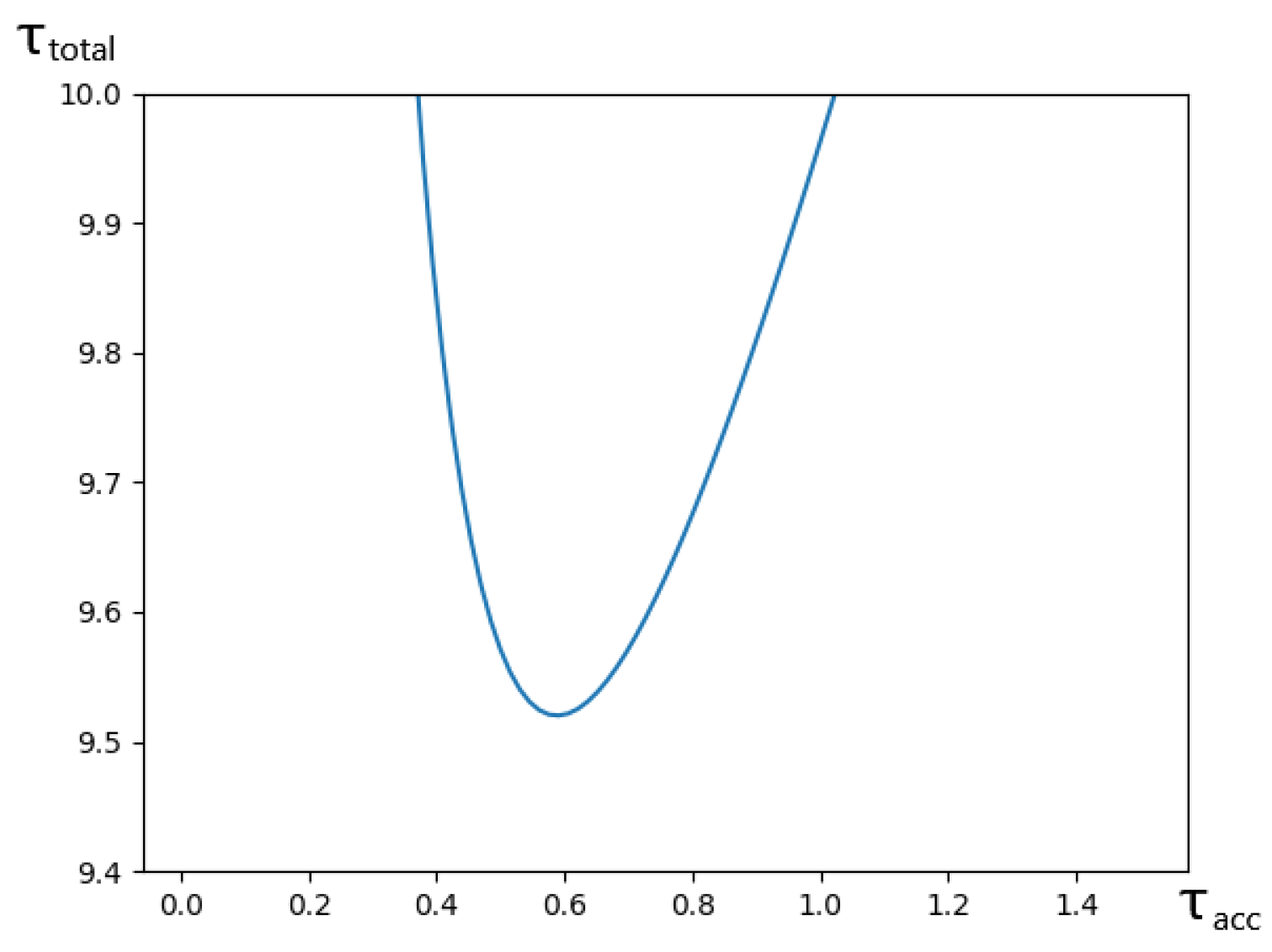1. Introduction
In the realm of theoretical physics, quantum mechanics and quantum field theory have been able to describe three out of four fundamental known forces till now which are the electromagnetic interaction, the strong force, and the weak force. Gravity, however, still does not have a complete theoretical model. Our current model of gravity is based on Einstein’s General Theory of Relativity which has been remarkably accurate in describing many phenomena from the bending of light around mass to gravitational waves. However a fundamental problem we face is that space-time interacts with energy-momentum which are properties of fundamental particles that are currently best described by the quantum theory. General Relativity and Quantum Theory are incompatible models due to a variety of reasons [
1], thus we must look for a way to introduce gravity to quantum physics.
In this paper we would look at an experimental proposal that aims to show that gravity can influence matter at quantum scales through the double Stern Gerlach Interferometer experiment devised by Bose et al in their paper [
2]. This experiment might be able to show how gravitational field could cause entanglement between two particles. The first portion would look at the experimental parameters that would maximize spin entanglement in the experiment suggested by Bose et al under optimal conditions such as reduced decoherence due to Casimir Polder interaction.
Later we discuss what the implications of this experiment are and exploring semiclassical models can serve as a bridge between completely classical and quantum theories of gravity. The final section talks about the path integral formulation of gravity, analyzing the Einstein-Hilbert Action, and explains how perturbative quantum gravity is non-renormalizable by power counting. The cutoff energy for perturbative gravity is calculated to show the limit to which it works as an effective field theory.
2. Double Stern Gerlach Spin Entanglement
Figure 1.
Schematic depiction of the double Stern-Gerlach experiment as proposed by Bose et al.
(a) Two mesoscopic particles of equal mass in this case in superposition of two spatially localized states .
(b) Evolution of states in SG interferometer into spin entangled states
Only the
component of energy-momentum tensor is non-negligible due to speeds much slower than the speed of light
c[
2], hence only
component evolves (where
is the small perturbation in linearized gravity
,
being the Minkowskian metric.)
Figure 1.
Schematic depiction of the double Stern-Gerlach experiment as proposed by Bose et al.
(a) Two mesoscopic particles of equal mass in this case in superposition of two spatially localized states .
(b) Evolution of states in SG interferometer into spin entangled states
Only the
component of energy-momentum tensor is non-negligible due to speeds much slower than the speed of light
c[
2], hence only
component evolves (where
is the small perturbation in linearized gravity
,
being the Minkowskian metric.)
As suggested in Ref.[
2], we keep two test masses in superposition of spatially localized states
and
. Their evolution happens under gravitational interaction and all other forces are minimized. These two states are localized Gaussian wavepackets and due to their relatively small diameters with respect to their distances
and
, we can assume
.
In this setup, we take two masses and with the centers of the left and right states of both the particles separated by the distance as shown in the figure.
Closest distance between and is and farthest distance between and is .
The Classical gravitational potential energy is .
The initial state at
is:
Using Schrödinger’s equation :
The general solution is found to be when the Hamiltonian is time-independent and is the unitary time-evolution operator.
As E is an eigenvalue of the Hamiltonian, we can write the final state as
At
, the state evolves to:
Where
and .
A state is said to be entangled if it cannot be factorized (non-separable) to be written as a product of states such as
(a separable state). If we try to factorize Eq(3), we obtain:
The condition for this to be completely factorizable would be if .
means where n is an arbitrary integer.
Therefore for the state to be entangled,
This gives us the entanglement condition:
The SG interferometer accelerates the particles through a magnetic gradient for a time and then the magnetic field is switched off for a greater amount of time enough to entangle both the superposition states.
In this process, the two joint states of the test masses evolve as shown in Eq.(1) and Eq.(3) the orbital states
and
get replaced by the spin-orbital qubit states
and
.(Ref.[
2]).
Replacing the states in Eq.(3) with the spin-orbital states gives us:
In the final step, the superposition is brought back through unitary transformations
,
This entanglement can be measured using an entanglement witness which is discussed later in Appendix A. If satisfies a certain condition for example exceeding unity in the one Bose et al. suggested, then the state is proven to be entangled.
3. Minimization of Casimir-Polder Interaction
While performing the experiment, it is important to reduce extra noise that may present itself due to other forces between the two particles we are using. One of them is the Casimir force which we will try to reduce.
We will be taking a linear setup for the experiment[
3] and the particles as diamond nanoparticles of mass
.
The formula for the Casimir force between two neutral dielectric particles is
Where R is the radius of the particles, is the minimum distance between them, c is the speed of light in vacuum (m/s), ℏ is reduced Planck’s constant (Js)and is the dielectric constant (∼ 5.7 for diamonds).
For a minimum difference of one order of magnitude[
3], we obtain
Thus we need the minimum distance between the entangled particles to be for the Casimir force to be negligible (one order of magnitude lower than gravitational force in this case).
4. Conditions for Maximal Entanglement
We will be converting the quantum state to a density operator () in order to perform certain operations on it.
The state can be written as
Here and
The density matrix is evaluated to be
The bipartite von Neumann entropy can help us find the maximally entangled state of a quantum system and is represented by
Where and are the reduced density matrices.
The reduced density matrix was calculated to be:
The system is maximally entangled when
and
are maximally mixed[
4] which is achieved when they are diagonal matrices with diagonal elements as
where
d is the dimension of the Hilbert space of the basis (which is 2 in our case).
To get these conditions, we set the non-diagonal entries to 0 first:
and
This gives us two equations
They can be written as
by collecting the real and imaginary parts of the expressions.
For to be 0, and (where ℜ and ℑ are the real an imaginary components of the complex number respectively)
Looking at the imaginary part,
This implies that
Which means either
or
where
k is an arbitrary integer.
Substituting Eq(10) in the real part,
This is not a satisfactory condition as for only some values of
Thus we can assume, . This leads us to using Eq(11) as follows:
This satisfies the given conditions, therefore
This is our condition for non-diagonal elements being 0. Now to verify for maximally mixed state, we can substitute these values in the reduced density matrix.
So
By analogy with the classical entropy formula, the entanglement entropy has the following bounds:
As the system saturates the upper pound, the state is maximally entangled.
Figure 2.
Plot of Entanglement Entropy as a function of
(from 0 to
) and
(from
to
).
It can be seen that the entropy achieves its maximum value of when the sum of the phases approach .
Figure 2.
Plot of Entanglement Entropy as a function of
(from 0 to
) and
(from
to
).
It can be seen that the entropy achieves its maximum value of when the sum of the phases approach .
Now we can substitute the values of the phases to get an expression for the distances. For simplicity, we will take
in Eq(12).
gives
The expression for the distance between the left and right states is[
2]:
Where is the electronic g-factor, is the Bohr magneton, is the magnetic field gradient in the x-direction. The mass of the particles we are taking is kg, the magnetic field gradient is , is the time the masses are subjected to the magnetic field gradient and is a variable.
Substituting the distance for minimized CP-effect,
, we get:
As the experiment cannot be completely free from outside interaction, there would always be some sort of decoherence in the system. The collisional decoherence time is approximately of the same magnitude as the total fall time of the particle
[
2]. This will lead to a strong loss of coherence which will interfere with the gravitational entanglement. To minimize this, we can minimize the total time taken for the particle to fall (
.
Minimizing
by a simple python program mentioned in Appendix C gives
and
Using these values, we can obtain the distances between the entangled states as
Calculating the phase values:
This gives .
These values can be substituted in Eq(12) to verify that the maximal entanglement conditions are met:
Some rounding error of % persists, however, it is almost negligible.
5. Inferences and Semiclassical Models
In order to make inferences from the proposed experiment, we will first need to know its assumptions and limitations.
The main theoretical assumptions of the Bose et al [
2] paper is that the gravitational interaction between two masses is mediated by a gravitational field (not a direct action at a distance) and that entanglement between two systems cannot be created by Local Operations and Classical Communication (LOCC).
Another assumption made by them is using the Newtonian potential for mediating the gravitational entanglement which is not the true degree of freedom of the gravitational field and hence might have affected the implications of the experiment. (Discussed thoroughly in Ref.[
5])
Based on the given assumptions, the entanglement generated by gravity would be non-classical. However, even if it eliminates the possibility of a completely classical model of gravity, it does not strictly imply that gravity is quantum and a semi-classical model of a gravity is still a valid possibility.
Due to the success of the general theory of relativity in explaining gravity, a good start to uncovering a valid theory would be to look at the semi-classical models of gravity. The classical Einstein’s Field Equations are
Where
is the Einstein Tensor and
is the stress-energy tensor. However in a quantum scenario, the stress-energy tensor is promoted a quantum operator
which would be inconsistent with the left half of the equation which is why we take its expectation value according to Møller-Rosenfeld[
5][
6], giving us a classically measured value of the operator.
Here
. We do run into mathematical and physical inconsistencies in this equation one of them being that the expectation value of the energy-momentum operator is not conserved while the Einstein tensor is conserved (
). Thus we need to renormalize
which would give us
and other conditions discussed by Wald[
7].
Another flaw with the field equations semi-classical gravity is that the expectation value in some cases implies that the net curvature of the superposition states would be averaged out in the center and we would expect a test particle to move towards that center. This is not what experiments have shown so it is a massive downside of this model. ([
8][
9]) This type of approximate semiclassical gravity where
does have some applications one of which includes the calculation for Hawking Radition of Black Holes[
10].
Figure 3.
a) Observed behaviour of particle in superposition vs b) Expected behaviour in Møller-Rosenfeld semi-classical gravity. (Credits: Designed using desmos.com/3d)
Figure 3.
a) Observed behaviour of particle in superposition vs b) Expected behaviour in Møller-Rosenfeld semi-classical gravity. (Credits: Designed using desmos.com/3d)
Due to the limitations of this model, other semi-classical models have also been proposed, an important one being the stochastic model[
11].
Two of the current leading models for quantum gravity are the Loop Quantum Gravity model[
12] and the String Theory[
13] which would not be discussed here being beyond the scope of this paper.
In conclusion, new experiments might help us eliminate more erroneous models and get closer to the right one.
Quantized Gravitational Field Theory
Gravitational Action
In flat spacetime QFT, we ordinarily set up a spacetime manifold
and integrate on quantum fields. However, in gravity spacetime is dynamic so we have to integrate over the geometries of spacetime itself. The propagator
is defined to be the probability transition amplitude between the wave-functions evaluated at two points. This can be defined in terms of the path integral:
Where
g is a spin-2 tensor field,
is a matter field,
is a surface, and I is the action. The subscripts
i and
f represent the initial and final states respectively [
14].
The simplest choice for such an action would be the Einstein-Hilbert action.
Here , Ricci scalar , , and is the matter field’s Lagrangian density.
To derive the equation of motion, by the stationary principle action we neet to set
. For simplicity, we’ll consider the action without the matter interaction.
To vary S, we need to first find the variation of R and . Starting with g:
Any diagonalizable matrix A obeys the identity
Since
, the inverse can be written as the metric with raised indices as
Using the derivative of inverse matrix formula,
can be written as
and thus
can be rewritten as
The variation of
would be
Thus the variation with respect to
is
Next, we vary the Ricci Scalar
R. Since
, using the product rule we get
Where
becomes a total derivative on being multiplied by
. Using Stokes’ Theorem
, the total derivative part of the action can be written as
Where is the manifold we’re integrating on and is a closed hypersurface of the manifold.
This boundary term does not contribute to the variation of S () as it is dependent on the variation of the metric tensor () which vanishes in a neighborhood of a boundary or when there is no boundary. When the manifold has a boundary, the result is the Gibbons–Hawking–York boundary term.
Finally, the variation of
S can be calculated
So for
, we have
Substituting the terms calculated previously
This can be written in the form
Thus we obtain the equation of motion as the Einstein Field equations in a vacuum.
By varying the EH-Action containing the matter Lagrangian, the complete field equations can be obtained with the stress-energy tensor.
Dimensional Analysis
For this paper, I will be using natural units and mass dimensions.
The natural units are
. On applying dimensional analysis, it can be concluded that
Similarly for the reduced planck’s constant,
Using this, we can analyze the dimensions of other quantities.
Note that for some unknown quantity
x,
can also be written as
as we’re only referring to mass dimensions. Since the action
S appears in the path integral as
, it must be dimensionless. Thus in 4 dimensions,
.
Now to analyze the gravitational action, we first need the dimension of the coupling constant
. This can be calculated by referring to Newton’s inverse square law of gravity.
Power Counting Renormalizability
Consider a pure scalar field theory in d-dimensions
Where
is the field,
is the coupling constant, and
is the interaction term[
15]. In the Feynman diagrams, the contributing propagators are of the form
and the loops are of the form
. Let the dimension of the propagators be
P and
L for the loops.
The degree of divergence is defined as
Let the Lagrangian density’s dimension be . This means .
Analyzing the kinetic energy term,
. So the dimension of the field is
Coming back to the interaction term,
. Solving for
,
For an arbitrary diagram with
N external legs and
V vertices, the interaction term is
. The dimension of
is
Therefore any diagram with N external legs has dimension
. The most divergent part is proportional to
and by dimensional analysis,
Since , we can classify this theory into three degrees of renormalizability:
Super-Renormalizable:
Renormalizable:
Non-Renormalizable:
Since , the gravitational perturbation theory is non-renormalizable by the power counting method.
This can be observed in QED where the coupling constant (fine structure constant) is dimensionless and the theory is renormalizable.
Now to expand the scattering amplitude perturbative series in terms of
E with the coupling constant
G, in order for it to be dimensionless it should be in terms of
since
and
[
16]. Thus we obtain
Looking at the first loop corrections to the action,
By dimensional analysis, , . Hence it can be observed that the E-H term is proportional to , and the one-loop corrections are proportional to . Continuing this trend, the two-loop corrections would be proportional to and thus are of the form where R is shorthand for either Riemann, Ricci curvature tensor or scalar.
More accurately, the one-loop corrections are
also known as the Gauss-Bonnet Term.
The gravitational constant is also proportional to the inverse of the planck mass squared.
Rewriting Eq(21) with the coupling as the Planck mass,
The sum
diverges when
. Thus, [Appendix D]
This means new physics must emerge at higher energy level than this. Gravitational field theory acts as a low energy effective field theory for energies .
To cancel the UV divergences in perturbative quantum gravity, an infinite number of counterterms need to be added to the Lagrangian. This makes the theory non-predictive since an infinite number of experiments would be required to obtain the counterterms’ coefficients. To fix this UV divergence, a UV complete theory must be formulated. One such theory is the string theory[
13].
Acknowledgments
I would like to express my deepest gratitude to Dr. Damián Pitalúa-García for his invaluable guidance and mentorship, which has been instrumental in helping me build a solid foundation in quantum physics. His expertise and insights into the key concepts explored in this paper have been indispensable in shaping my understanding and contributing to the quality of this work. I am also thankful to Mr. C.K. Campbell for helping me understand certain aspects of the experiment and for assisting me in locating essential research papers that served as crucial background reading for my paper and overall research.
Appendix A. Entanglement Witness
Entanglement witnesses are functions (often applied to the density matrix) to show that a state is entangled. These witnesses are useful as they do not give false positives and are helpful in confirming whether a given state is entangled. Of course a witness might not be able to detect all entangled states but they can be optimized to detect most of them.
Figure A1.
Diagram depicting convex set of quantum states including separable and entangled states. The witness detects more states than and hence, is more efficient.
Figure A1.
Diagram depicting convex set of quantum states including separable and entangled states. The witness detects more states than and hence, is more efficient.
Entanglement Witness suggested by Bose et al [
2] is
.
Their condition is that if then the state is proven to be entangled. To verify this we will use the bell states as they are maximally entangled.
For
:
Similarly,
As we can observe even the maximally entangled bell state does not exceed unity for this entanglement witness hence it might not be useful for the states calculated in this paper which is why the need to use a different witness arises.
Here we can use the common entanglement witness for entangled states.
The state is
Evaluating the witness for this state:
As , we can say that the obtained state is definitely entangled.
Appendix B. Density Matrix Calculations
For notational convenience, we will be taking and .
In
Section 4, the quantum state used is
The conjugate transpose of this ket is the corresponding bra:
The density operator
This can be converted to matrix notation using the following:
Similarly,
The reduced density matrix is defined as
Where is the identity operator in and is the partial trace of the density matrix.
As
when
, this leaves us with
Appendix C. Minimization of Time Taken
Our minimization expression is .
The minimization constraint is Eq(15) which we will be simplifying by assigning variables to the numerical constants
Now this can be rearranged to define
as a function of
as
By substituting Eq(23) in our minimization expression, we obtain a function in one variable which can be minimized using a simple python code.
import numpy as np import scipy as sp
from scipy.optimize import minimize
Defining constants A = 9.274*10**(-3) B = 157*10**(-6) C = 49455.3566
Defining function def f(x): y = 2x + (C*(A*(x**2)+B)*(2*A*B*(x**2)+(B**2)))/(2*(A**2)*(x**4)) return y
Minimization res = minimize(f, 0.2)
res
This gives , and .
Figure A2.
Graph of as a function of .
Figure A2.
Graph of as a function of .
Appendix D. Energy Cutoff for pQG
Eq. 22 shows that the energy cutoff of perturbative quantum gravity should be of the order
. This can be calculated as follows:
The conversion from SI units to Natural units is shown in the table below:
| Quantity |
SI Units |
Natural Units |
Conversions |
| Force |
|
|
1 Newton =
|
| Mass |
|
E |
1 =
|
| Length |
m |
|
1 m =
|
Substituting these values into Eq. 24 :
Therefore, .
References
- Macías, A. On the incompatibility between general relativity and quantum theory. 2008.
- Bose, S.; Mazumdar, A.; Morley, G.W.; Ulbricht, H.; Toro, M.; Paternostro, M.; Geraci, A.A.; Barker, P.; Kim, M.S.; Milburn, G.J. Spin Entanglement Witness for Quantum Gravity. Physical review letters 2017, 119 24, 240401. [Google Scholar] [CrossRef]
- Schut, M.; Grinin, A.; Dana, A.; Bose, S.; Geraci, A.A.; Mazumdar, A. Relaxation of experimental parameters in a Quantum-Gravity Induced Entanglement of Masses Protocol using electromagnetic screening. 2023.
- Nielsen, M.A.; Chuang, I.L. Quantum Computation and Quantum Information; Cambridge University Press, 2000.
- Lichnerowicz, M.A.; Tonnelat, M.A., Eds. Proceedings, Les théories relativistes de la gravitation : actes du colloque international (Relativistic Theories of Gravitation): Royaumont, France, June 21-27, 1959, Paris, 1962. CNRS.
- Rosenfeld, L. On quantization of fields. Nucl. Phys. 1963, 40, 353–356. [Google Scholar] [CrossRef]
- Wald, R.M. Trace anomaly of a conformally invariant quantum field in curved spacetime. Phys. Rev. D 1978, 17, 1477–1484. [Google Scholar] [CrossRef]
- Eppley, K.R.; Hannah, E. The necessity of quantizing the gravitational field. Foundations of Physics 1977, 7, 51–68. [Google Scholar] [CrossRef]
- Page, D.N.; Geilker, C.D. Indirect Evidence for Quantum Gravity. Physical Review Letters 1981, 47, 979–982. [Google Scholar] [CrossRef]
- Lowe, D.A.; Thorlacius, L. Semiclassical dynamics of Hawking radiation. Classical and Quantum Gravity 2023, 40, 205006. [Google Scholar] [CrossRef]
- Martí n, R.; Verdaguer, E. Stochastic semiclassical gravity. Physical Review D 1999, 60. [Google Scholar]
- Ashtekar, A.; Bianchi, E. A short review of loop quantum gravity. Reports on Progress in Physics 2021, 84. [Google Scholar] [CrossRef] [PubMed]
- Seiberg, N.; Witten, E. String theory and noncommutative geometry. Journal of High Energy Physics 1999, 1999, 032–032. [Google Scholar] [CrossRef]
- Hawking, S.; Israel, W. General Relativity: an Einstein Centenary Survey; 2010.
- Peskin, M.E.; Schroeder, D.V. An Introduction to quantum field theory; Addison-Wesley: Reading, USA, 1995. [Google Scholar]
- Zee, A. Quantum field theory in a nutshell; 2003.
|
Disclaimer/Publisher’s Note: The statements, opinions and data contained in all publications are solely those of the individual author(s) and contributor(s) and not of MDPI and/or the editor(s). MDPI and/or the editor(s) disclaim responsibility for any injury to people or property resulting from any ideas, methods, instructions or products referred to in the content. |
© 2024 by the authors. Licensee MDPI, Basel, Switzerland. This article is an open access article distributed under the terms and conditions of the Creative Commons Attribution (CC BY) license (http://creativecommons.org/licenses/by/4.0/).
